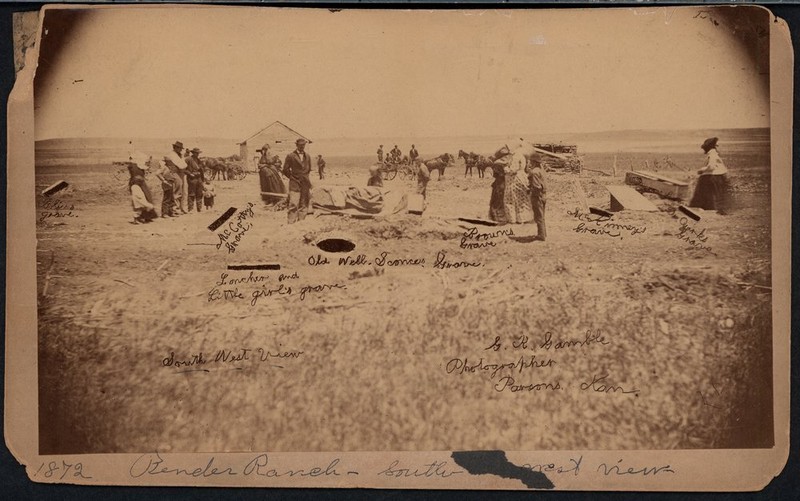The Bloody Benders Historical Marker
Introduction
Text-to-speech Audio
After the Civil War ended, the US relocated Native Americans from southeast Kansas to a territory that would later be known as Oklahoma. The Homestead Act of 1862 brought many people to Kansas, including the Bender family. The bender family was composed of John Bender Sr; Almira, his wife, son, John Jr, and daughter Kate. They built a cabin that split so that it was a small inn and also a convenient store. It was just off the Osage Mission-Independence trail that many people would travel to get to their desired destination. That is how they found their victims. The Bender family is known as America's first family of serial killers. Their crimes began when the store opened from 1871 to 1873 at the property where they lived.
Images
The Bender family; John Bender Sr, Mrs. Bender, John Bender Jr, and Kate Bender

Historical Marker located in the rest area at the Junction of U.S. 400 and 169 north of Cherryvale

Bender Mounds: Piece of acreage named after the family

Cherryvale Museum

Bender Ranch 1872

Backstory and Context
Text-to-speech Audio
The Bender family chose a 160-acre land on the western slope of the mounds. Their store and inn brought in many travelers who thought they were staying at a safe, family-owned location. The Benders settled in the western part of Labette county, along with five' spiritualists’ families; the families were seen as a cultish bunch. John Bender Jr was 60 years old, standing over six feet tall, with big bushy eyebrows. Mrs. Bender was 55 at the time they moved to Kansas and was a heavy-set woman. She was also known as an unfriendly woman who claimed to be a medium. John Bender Jr was 25, handsome, tall, and slender. Kate was considered the friendliest, with excellent social skills. She was a self-proclaimed psychic and healer who frequently performed seances. She often advocated for free love as well. Kate's fascination with these movements makes sense given the period in which she lived. Historian Ann Braude, in Radical Spirits, argued that the spiritualist movement often intersected with the women's rights movement stating, "The two movements intertwined continually as they spread throughout the country. Not all feminists were Spiritualists, but all Spiritualists advocated woman's rights," and that "free love, abolition, and woman's rights all sought to liberate the individual from physical and spiritual domination by others and from the oppressive power of the state." (Braude, 2, 28)
When the store and lodge opened in 1871, many travelers with lots of money and intention to settle or buy items began to go missing. The first few missing travelers did not cause alarm since people missing or discontinuing their travel westward was common. After more people began to go missing, other surrounding towns made slandering accusations. In 1873, there was a town meeting over what actions could be taken to prevent these rumors. The Benders were part of the people who attended the meeting. After the session and searching for the missing people, the town noticed that the Benders family farm had been abandoned. The Benders' farm animals had not been fed. A trap door was discovered and inside was clotted blood. However, there were no bodies found in the hole. In the area the Benders had used as a vegetable garden and orchard, they discovered the first body. As the digging continued, nine other bodies were found, along with multiple dismembered body parts. The burial site was then referred to as “Hell’s half-acre,” one victim's brother offered a $1000 reward, and later on May 17th, a governor added an additional $2000 reward.
It was later found that the Benders were not even a true family. The only actual relatives were Ma Bender and Kate Bender. When visitors stopped for a meal, visitors were seated with their backs against a large canvas. There Kate would begin to charm the men by flirting and engaging in conversation. Pa and John Bender would hide behind the canvas and strike the victim when the time was right. Ma and Kate would then try to find the travelers' valuables and push him through the trapped door, where Kate would slit the victim's throat. The bodies would be buried later in the garden and orchard. After the discovery of the bodies, including a seven or eight-year-old girl, the Benders had only gained about $4600 and a couple of other items.
It was thought that the Benders had separated and fled to different parts of the country. However, no one actually knows what happened to the family. Dave Alexander and Aletta Fox Hutchins referred to it as “one of the great unsolved mysteries of the West” since none of the murderers were ever caught. In the late 1880s, two women were arrested in Michigan, thought to be Ma and Kate Bender. They were never proven to be, and the charges against them were dropped due to lack of evidence. Located about eight miles near the site, there is a historical marker about the Bloody Benders and their crimes. Their original cabin was torn down and was later rebuilt as a museum. The place was a high place of tourism and brought in thousands. That museum was then later torn down and a new museum was built, located in Cherryvale, which has all of the memorabilia from the original museum. Today the Benders mound is on the market.
Sources
Braude, Ann. Radical Spirits: Spiritualism and Women's Rights in Nineteenth Century America. Bloomington, IN: Beacon Press, 1989.
Alexander, Dave and Hutchins, Aletta Fox, "The Bloody Benders — Serial Killers of Kansas.” Legends of America. Accessed April 22, 2021. http://www.legendsofamerica.com/ks-benders
Kim, Allen. “A Property That Once Belonged to a Family of Serial Killers Known as the 'Bloody Benders' Goes up for Sale.” CNN. Accessed 6 Feb.2020, www.google.com/amp/s/amp.cnn.com/cnn/2020/02/06/us/bloody-bender-house-trnd/index.html.
Bloody Benders.” The Wichita Daily Eagle, 26 Nov. 1889, p. 7. Library of Congress: Chronicling America. Accessed 23 Mar. 2021. chroniclingamerica.loc.gov/data/batches/khi_hickok_ver01/data/sn85032490/1889112601/0503.pdf.
